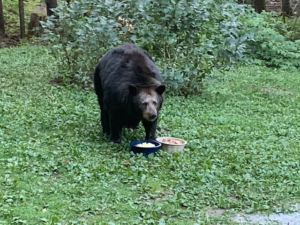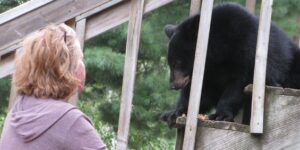Oct 5, 2021
I had the privilege of participating in a life-changing wildlife educational experience about black bears. When I got home after the first year, I felt I hadn’t made the most of this incredible opportunity. A guided learning journal I created for year two helped me remember what I learned and transfer the learning to action when I got home.
Learning from Black Bears
 The Black Bear Field Course with the Wildlife Research Institute in Ely, Minnesota is a 4-day experience of learning in an immersive environment with bears about their body language, social interactions, family structure, co-existing with humans and more. We stayed at the research center and expanded on the learning in lectures, ecology trips, educational offerings at the North American Bear Center, and discussions with leaders and other participants, many who come back year after year. There are very large 600-pound and over male bears, moms with cubs, and my favorites, the yearlings who will be making their own dens for the first time come winter. The research center tracks the bears seen and the matriarchal lineage of a family headed by senior bear Shadow (age 30 in picture) to note numbers and sex of cubs, age of mothers bearing cubs, diversionary feeding research and more. In their 50 years of research they have also hosted den cams in the winter months and used radio collars to follow particular research bears.
The Black Bear Field Course with the Wildlife Research Institute in Ely, Minnesota is a 4-day experience of learning in an immersive environment with bears about their body language, social interactions, family structure, co-existing with humans and more. We stayed at the research center and expanded on the learning in lectures, ecology trips, educational offerings at the North American Bear Center, and discussions with leaders and other participants, many who come back year after year. There are very large 600-pound and over male bears, moms with cubs, and my favorites, the yearlings who will be making their own dens for the first time come winter. The research center tracks the bears seen and the matriarchal lineage of a family headed by senior bear Shadow (age 30 in picture) to note numbers and sex of cubs, age of mothers bearing cubs, diversionary feeding research and more. In their 50 years of research they have also hosted den cams in the winter months and used radio collars to follow particular research bears.
My first year, I was so overwhelmed with newness, excitement and the immersive process that I took lots of pictures, but made no notes, and so I didn’t remember all of what I learned. For year two, I created a personal learning journal for myself and shared a prototype for potential use with other field course participants.
A Holistic Learning Journal
 I didn’t want to just write down everything I saw and heard, I wanted to use the journal to guide my thoughts and feelings towards future action and support of black bears. I used GLP’s 4A Sequence of learning tasks for a holistic approach that helps the learning stick by holding space for what I already knew about bears all the way through what actions I wanted to take when I got home. I also used open questions that led to deeper thoughts about what I was learning and didn’t prescribe what the responses might be. Here are some sample questions in the 4A sequence:
I didn’t want to just write down everything I saw and heard, I wanted to use the journal to guide my thoughts and feelings towards future action and support of black bears. I used GLP’s 4A Sequence of learning tasks for a holistic approach that helps the learning stick by holding space for what I already knew about bears all the way through what actions I wanted to take when I got home. I also used open questions that led to deeper thoughts about what I was learning and didn’t prescribe what the responses might be. Here are some sample questions in the 4A sequence:
ANCHOR – accessing prior knowledge or experience
- Where have I seen images of bears? What did they tell me?
- What do I want to get out of this experience?
ADD – experiencing new learning
- What did I learn about animals/environment today?
- What more do I want to know?
APPLY – doing something with the new learning
- How have others advocated or supported black bears?
- How do I plan to be a bear ambassador?
AWAY – connecting the new learning to future use
- How will I continue to support the WRI and NABC?
- Who do I plan to tell about what I learned?
Good Ideas from Others
In sharing my prototype with educator and wildlife rehab friends, other creative ideas suggested included: a scrap book section for collected memories, information about and by other participants in the course, and creating a crossword puzzle with bear facts and trivia. These great ideas added to the fun and interest of the journal when shared with others.
Here are some excerpts from my learning journal for inspiration.
How can you use a learning journal to increase the impact of your personal learning?
***********
Rachel Nicolosi is Communications Lead and Partner with Global Learning Partners. She continues to volunteer and support the Wildlife Research Institute and the North American Bear Center and will talk your ears off about black bears if you ask. Here are more blog posts by Rachel.
For more information about the 4A sequence
For more information about open questions:



